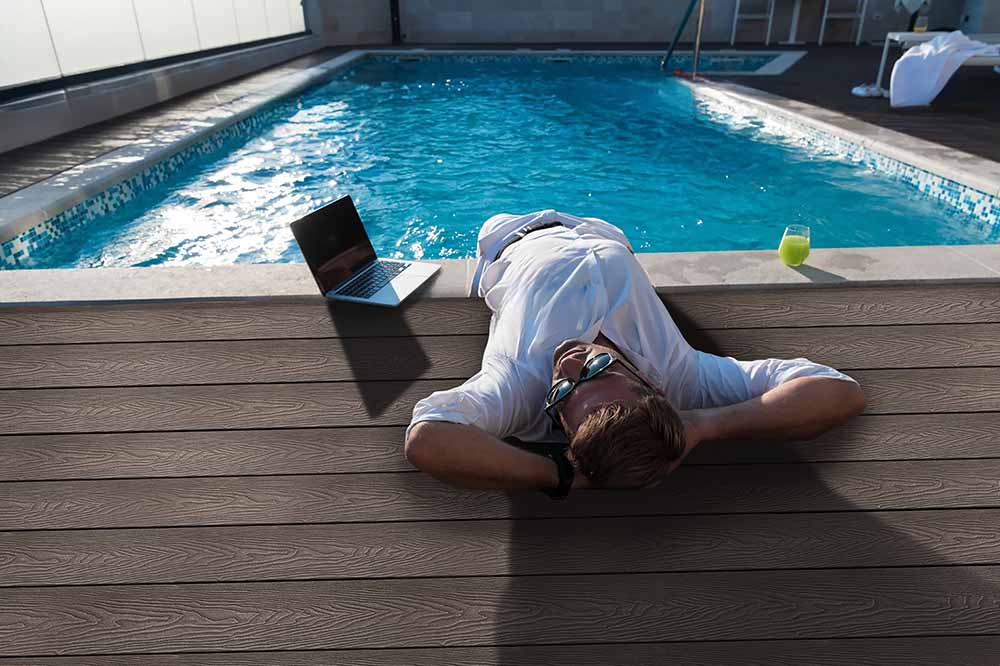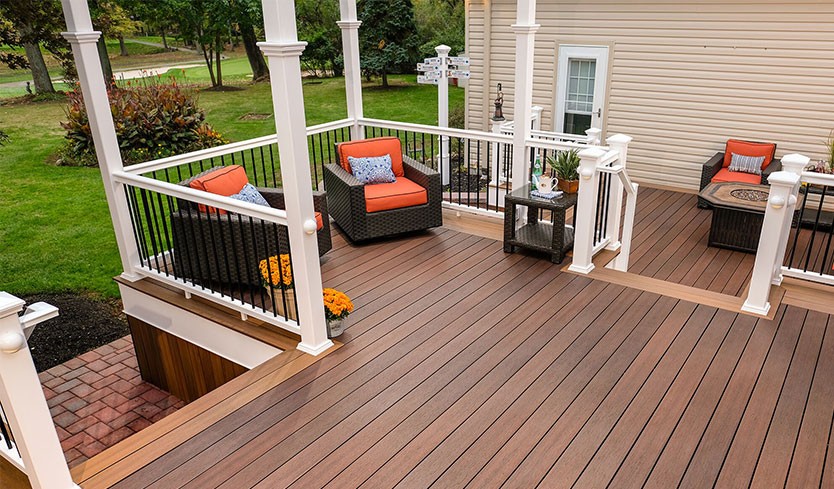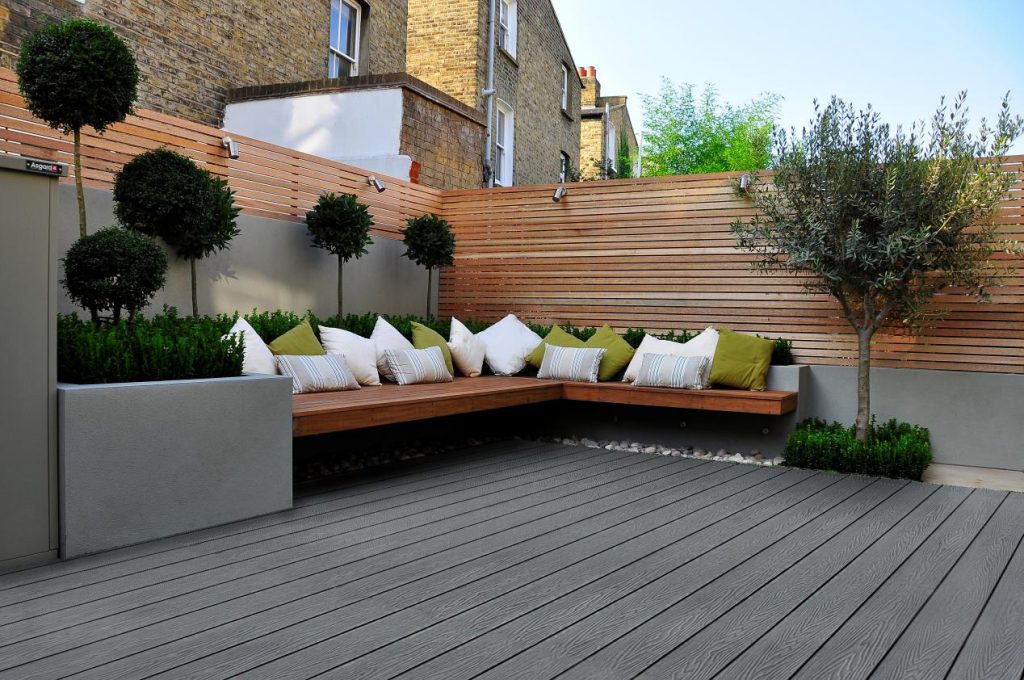Planning a poolside paradise begins with choosing the right decking material, and composite pool decking has become a top choice for both inground and above ground pools. Whether you’re upgrading an existing pool or building a new one, composite decking offers a blend of durability, low maintenance, and modern aesthetics. Unlike traditional wood or concrete, it resists moisture, fading, and splintering—making it ideal for wet, sun-exposed environments. In this guide, we’ll cover everything you need to know about composite pool decking, from its materials and benefits to installation tips, design inspiration, and long-term care.
Ecoscape UK and Similar Brands
Table of Contents
What is Composite Pool Decking?
Composite pool decking is a modern, engineered alternative to natural wood. It’s typically made from a blend of recycled wood fibers and plastic (either polyethylene or PVC), resulting in a highly durable, weather-resistant material perfect for wet and humid environments like poolside areas.
Key Features:
Water-resistant and slip-resistant
Low-maintenance and splinter-free
Eco-friendly and sustainable
UV-stable (resistant to fading)
Wide variety of colors and finishes
Whether you have an inground pool or an above ground pool, composite decking provides a long-lasting and visually appealing solution that stands up to heavy foot traffic, chlorine, saltwater, and intense sun exposure.
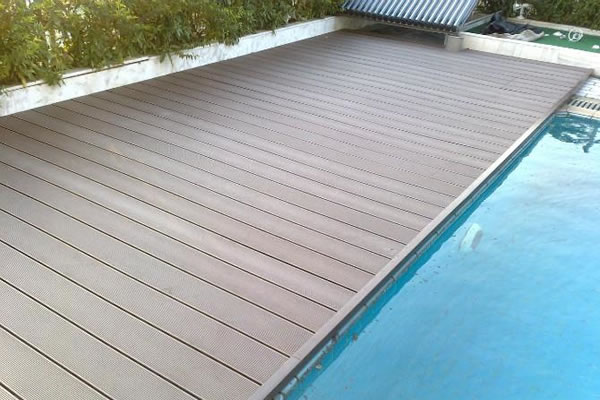
Composite Decking for Inground Pools
An inground pool offers a luxurious, seamless look to any backyard. However, it also demands decking that complements its elegance while enduring the elements. Composite decking delivers on both fronts.
Advantages:
Moisture Resistance:
Inground pools are surrounded by constantly wet surfaces. Composite pool decking is engineered to resist water absorption, unlike natural wood, which can swell, warp, or rot over time.Heat Dissipation:
Many modern composite decks are designed to stay cooler underfoot, even on hot summer days—a huge plus for bare feet around the pool.Customizable Aesthetic:
Composite decking comes in a variety of colors, wood grain patterns, and finishes that can mimic tropical hardwoods like Ipe, Teak, or Mahogany without the maintenance hassle.Safety:
Slip-resistant textures and splinter-free surfaces make composite decking a safer choice, especially for children and elderly users.Durability:
Inground pool decks are exposed to pool chemicals, UV rays, and temperature fluctuations. Composite decking handles all these stressors with ease and retains its look for years.

Composite Decking for Above Ground Pools
Unlike inground installations, above ground pools often require freestanding or elevated decking platforms. Composite decking is an ideal material for these structures as well.
Benefits for Above Ground Pool Decking:
Structural Strength:
Composite boards, especially when paired with reinforced aluminum or steel framing systems, offer excellent load-bearing capacity.Fast Installation:
Many composite decking systems come with hidden fasteners or modular kits, making DIY installation quicker and cleaner.Design Flexibility:
Create a wrap-around deck, multilevel platform, or sunbathing area with ease—composite decking adapts to a variety of structural layouts.Color Matching:
Match the color of your composite pool decking to your pool liner, patio furniture, or home exterior for a cohesive outdoor aesthetic.Cost-Efficient Over Time:
While the initial price of composite decking may be higher than wood, the long-term savings on maintenance, replacement, and refinishing make it a smart investment for above ground pools.
Types of Composite Pool Decking Suitable for Inground and Above Ground Pools
When selecting composite pool decking, understanding the different types available can help you make the best choice for your specific pool setup—whether inground or above ground. Composite decking materials come in various formulations and designs, each tailored to meet different performance and aesthetic needs around pools.
1. Wood-Plastic Composite (WPC) Decking
The most common type, Wood-Plastic Composite decking combines recycled wood fibers with plastic polymers. This blend creates a material that looks and feels like natural wood but offers superior resistance to moisture, rot, and insect damage. WPC decking typically features a textured surface that mimics wood grain, adding warmth and charm to your pool area. It’s ideal for both inground and above ground pools due to its durability and slip-resistant properties.
2. Polyethylene-Based Composite Decking
Some composite decking uses a higher percentage of polyethylene plastic, often with fewer wood fibers. This results in decking boards that are more resistant to fading, staining, and scratching—important factors for pool environments exposed to chlorine and sunlight. Polyethylene composites are usually more flexible and lighter, making installation around above ground pools easier, especially for elevated decks.
3. PVC Composite Decking
PVC (polyvinyl chloride) decking is a type of composite that contains no wood fibers, offering even greater resistance to moisture, mold, and mildew. This 100% plastic decking is highly durable and often smoother, with fewer grooves and textures. PVC decking is less prone to fading and staining, which is beneficial in pool areas. It’s especially popular for pool decks that require minimal upkeep and a sleek, modern look.
4. Capped Composite Decking
Many premium composite decking products come with a protective “cap” layer, a durable polymer shell that shields the board from UV rays, stains, and scratches. Capped composites combine the strength of wood-plastic blends with an extra layer of protection, extending lifespan and keeping pool decks looking new longer. This type is highly recommended for pool areas where exposure to chlorine, saltwater, and heavy foot traffic is constant.
Choosing the Right Type
For inground pools, durability and moisture resistance are paramount, so capped composite or PVC decking often provide the best performance. For above ground pools, lightweight polyethylene composites can simplify installation without sacrificing longevity.
Understanding these types helps ensure your composite pool decking matches your pool’s style, budget, and functional requirements—giving you a beautiful, safe, and durable deck for years to come.

Comparing Composite Decking vs. Traditional Decking Materials
| Feature | Composite Pool Decking | Natural Wood | Concrete | Pavers |
|---|---|---|---|---|
| Moisture Resistance | Excellent | Poor (unless treated) | Moderate | High |
| Maintenance | Very low | High | Moderate | Moderate |
| Lifespan | 25–50 years | 10–15 years | 15–20 years | 20+ years |
| Aesthetic Options | Many colors, grains | Limited to wood species | Limited | Variable |
| Slip Resistance | High | Low to Moderate | Variable | High |
| Eco-Friendliness | Recycled content | Renewable, but deforestation concerns | Not eco-friendly | Varies |
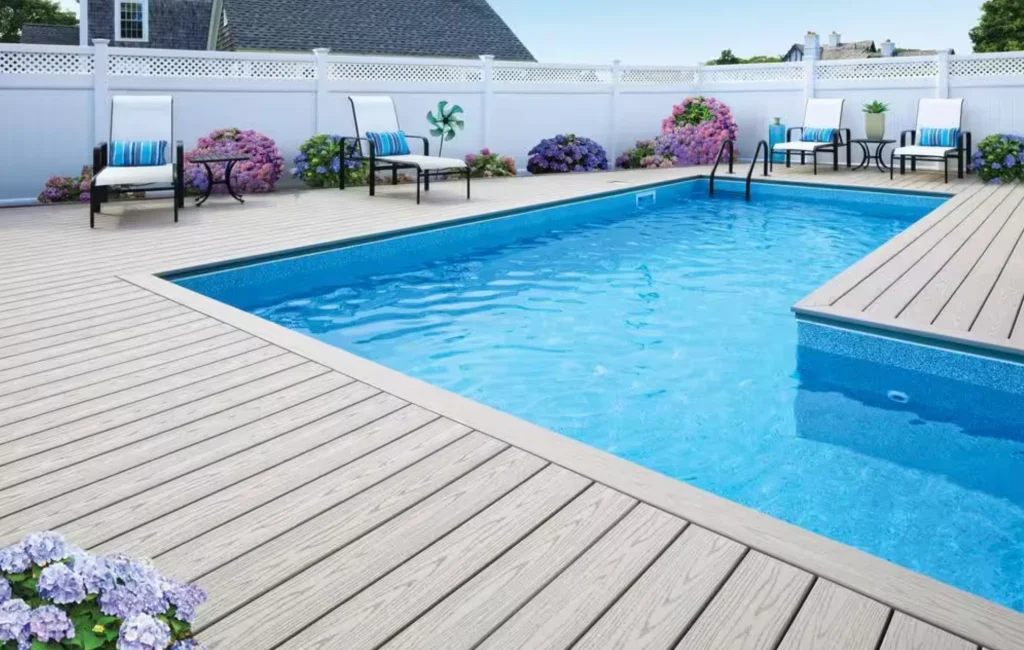
Design Ideas for Composite Pool Decking
Whether you want your pool area to feel like a tropical resort or a sleek, modern lounge, composite decking gives you the flexibility to bring your vision to life.
1. Wrap-Around Decks
Encircle your inground or above ground pool entirely with composite boards. Include built-in benches, lighting, and planters for a complete outdoor retreat.
2. Split-Level Designs
Use composite decking on multiple levels—one for the pool and others for dining, lounging, or a fire pit area.
3. Integrated Lighting
Incorporate LED lighting into your deck surface or railing to create ambient nighttime swimming environments.
4. Pergolas and Shade Structures
Composite decking pairs beautifully with wooden or composite pergolas, allowing you to define separate poolside zones.
5. Curved and Custom Cuts
Thanks to its flexible installation options, many composite deck systems allow for curved borders, giving your deck an organic, flowing design.
Composite Pool Deck Installation Tips
Installing composite pool decking isn’t drastically different from traditional decking, but a few best practices ensure a longer-lasting and better-looking result.
Key Tips:
Use proper fasteners: Many brands provide hidden clip systems for clean aesthetics.
Leave expansion gaps: Composite boards expand and contract with heat.
Install drainage systems: Especially important around pools to manage water runoff.
Reinforce substructure: Especially for above ground pools where elevated decks must support substantial weight.
Follow manufacturer instructions: Each brand may have unique requirements for spacing, orientation, or sealing.
How to Maintain Composite Pool Decking
One of the biggest advantages of composite decking is its low maintenance. You won’t need to stain, seal, or sand it every year like you would with wood.
Maintenance Checklist:
Sweep regularly to remove debris that may cause mold or mildew.
Clean with mild soap and water once a month or after heavy usage.
Use composite-safe cleaners if you have persistent stains or build-up.
Avoid power washers over 1500 psi, which may damage the surface.
Check hardware annually to tighten any loose fasteners or railings.
With basic upkeep, composite pool decking can look new for decades.
Is Composite Pool Decking Worth the Investment?
Absolutely. When considering the total cost of ownership—including installation, maintenance, repairs, and lifespan—composite decking often pays for itself over time.
Key Return on Investment Points:
No sanding, staining, or sealing needed
Resists rot, pests, and warping
Improves safety and slip resistance
Elevates the appearance and resale value of your property
Eco-friendly and sustainable material use
If you’re building a pool deck that you want to last for decades with minimal upkeep, composite pool decking is hard to beat.
Frequently Asked Questions (FAQ)
1. Is composite decking safe around pools?
Yes. It’s slip-resistant, splinter-free, and resistant to mold and mildew.
2. Does composite decking get hot in the sun?
Some darker colors can become warm, but many brands offer “cool-touch” technology to minimize heat retention.
3. Can I use composite decking with a saltwater pool?
Yes. Most composite boards are engineered to withstand salt, but confirm with the manufacturer to ensure compatibility.
4. How long does composite decking last?
With proper installation and minimal care, composite decking can last 25–50 years.
5. Is it more expensive than wood?
Initial costs are higher, but long-term savings on maintenance and replacement make composite decking more economical over time.
Final Thoughts
Whether you’re building an elegant inground pool deck or a stylish above ground pool platform, composite pool decking offers the perfect blend of beauty, safety, and durability. Its resistance to water, UV rays, and pool chemicals makes it the ideal material for high-performance outdoor living spaces.
If you’re ready to elevate your poolside experience with long-lasting style, it’s time to make the switch to composite decking. Explore your options, consult a professional installer if needed, and enjoy a summer full of hassle-free relaxation.
Ready to transform your pool area with composite decking? Contact Hosung WPC today to find out how we can help you design and build the ultimate poolside retreat using premium composite materials.

